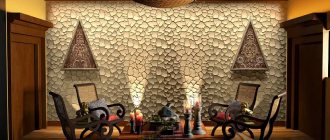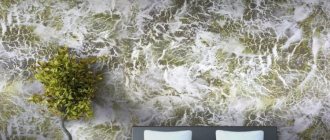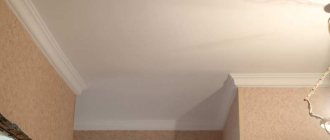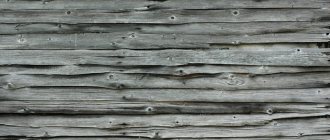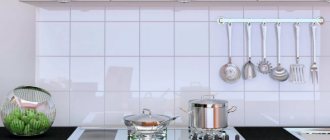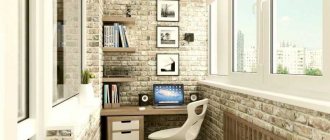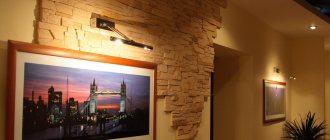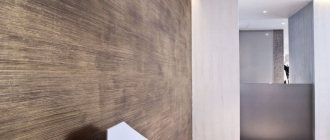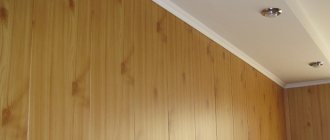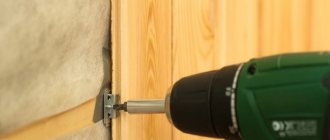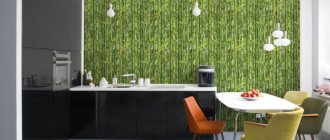The abbreviation MDF stands for medium density fiberboard. The entire production process is based on pressing finely dispersed fractions of wood chips under pressure. High temperatures promote the release of tree resin, which glues wood fibers together. Thanks to its manufacturing technology, MDF has:
- Environmentally friendly and exceptionally safe, no harmful substances or unpleasant odors are released during operation. MDF is suitable for use in residential premises and children's rooms.
- Strength, which eliminates sagging of wide shelves. The panels can withstand quite heavy loads. The ability to bend gives the furniture the desired design.
- Resistant to temperature changes and high humidity, which cannot be said about natural wood. Thanks to these qualities, the panels are used in the interior of kitchens and bathrooms.
- Immunity to mold and fungal infections, infection by microorganisms.
- Cheaper compared to natural wood and chipboard.
- Easy to install.
- Wide choice of colors.
With the help of wall panels, you can bring to life any design for the decoration of apartments and office premises. This is an excellent replacement for expensive materials. The panels can look like natural wood, plastic, textured plaster, or tiles. Covered with PVC film, the panel acquires a lacquered surface, which is widely used in furniture facades.
How to choose quality MDF panels
Even though MDF wall panels are relatively inexpensive, purchasing low-quality material can subsequently lead to disastrous results and repeated costs. To choose high-quality panels, follow these tips:
- Check the certificate of product compliance with quality standards. When purchasing, be sure to request this document from the seller. Its presence indicates the absence of harmful elements that may be used to produce these panels, such as toxic resins or formaldehyde.
- Visually inspect the entire batch of goods you plan to purchase. A large number of defective specimens should alert you. Any unevenness, cracks and other deviations from the norm are a sign of a low-quality product. It is highly not recommended to buy it, even if the price is too attractive.
- Look carefully at the colors. In addition to the uniformity of the color scheme, you need to check such a parameter as the evenness of the layer application. If there are irregularities, this indicates low quality of the product.
Popular manufacturers
Today, many companies around the world produce these products, however, not many can boast of good quality. Let's consider the rating of the best companies producing MDF panels:
- Swiss krono group. A large wood processing enterprise that has representative offices and factories in many countries around the world. The products are of European quality at domestic prices.
- P&M Kaindl. An Austrian company, one of the leaders in the production of MDF products. The plant has the most advanced equipment, which allows it to produce only high-quality products that are sold all over the world, including in our country.
- Sonae Industry. The company from Portugal is also one of the largest in the world. It has been producing MDF boards for almost 30 years. During this time, she has proven herself to be the best.
- LLC "Master and K" A domestic company that has existed for more than 20 years. The high-quality products of this plant are used and sold not only in Russia, but also in many countries around the world. The company's product range is constantly expanding.
Installation tools
Before you begin installation work, you should prepare the necessary tools. Would need:
- A plumb line, which will be used to determine the verticality of individual elements of the sheathing;
- Level for controlling the verticality and horizontality of elements;
- A corner, using which the mating elements can be positioned at an angle of 90 degrees;
- Hammer;
- Screwdriver;
- A hacksaw for woodworking or a jigsaw;
- Construction stapler with staples;
- Tape measure for taking measurements;
- Pencil for marking;
In addition to the tools, you should prepare consumables and materials. You will need not only the MDF panels themselves, but also a metal profile or wooden blocks to make the frame. The choice depends on the installation order. You will also need fastening elements, which can be self-tapping screws and nails.
If the elements will be attached using the adhesive method, you need to purchase a sufficient amount of adhesive or liquid nails.
Options in the interior
- You can add variety by using different colors. In this option, a unifying direction is chosen - all panels have a natural wood pattern, but the shades differ. This effect is similar to a mosaic, but it does not seem too intrusive, since a restrained range of brown tones is maintained, including the molding, which is used to highlight the decor. The material here goes well with the stone that is used to decorate the small wall on the side.
- Panels can only occupy part of the space; it is not necessary to decorate the entire room with them. The combination of such products in the lower part with wallpaper located above is a classic solution. If you like Victorian style and English classics, then you can choose this option and create a discreet but elegant interior using MDF.
In the next video you will see the installation of MDF panels on the walls.
Characteristics and scope of application by type of material
We won’t talk about PVC panels. There is a separate article about them with a detailed description of the technology for mounting on walls and ceilings. In this paragraph, we will consider wall panels for interior decoration made from other materials. There are more than enough of them. There are the usual MDF and chipboard, there are exotic bamboo, glass, and metal.
Wall decoration with decorative panels is becoming increasingly popular
Beautiful examples
MDF wall products can be installed in a wide variety of rooms, from active rooms and cafes to rooms in apartments or houses. Many builders may associate such finishing material with “official” and boring decor, but in fact this is not the case - thanks to the chic choice of colors and textures, beautiful and stylish compositions can be created from such panels. At the same time, in the interior decoration of rooms, products not only with imitation wood, but also other natural materials look good
In addition, wall sheets can be perfectly combined with various inserts, so you can get a stunning design effect. When choosing panels for decorating a living room, it is important to consider what functions the room will perform and how many spatial zones it consists of. Most often, the walls of the living room are decorated with products in a classic style.
They do this in such a way that they are a kind of continuation in the decor of the fireplace, doorways, stairs and other interior items. It is recommended to alternate panels of light and dark wood or combine two shades at the same time. For example, the living room looks original, in which one wall is lined with light oak panels, and the other with dark wenge panels.
- In addition, in rooms that combine a recreation area and a dining room, you can make combined horizontal paneling. Dark-colored material will be placed below half the wall, and light-colored material will be placed on top. To hide the places between color transitions, it is recommended to install additional decor from a wooden plank. Walls that are paneled vertically from floor to ceiling also look interesting in living rooms. Due to the fact that the material attached to the base acquires a plank structure, the surface becomes striped, as a result of which the space visually expands.
- Laminated MDF products will become a real decoration for the kitchen. As a rule, for this type of room, materials with imitation wood and natural stone are chosen. With the right design, such panels will help make the room modern and stylish, filling it with homeliness and comfort. Most often, veneered or laminated MDF boards are used for the kitchen - they are close to wood in their beauty and structure, so it is recommended to place them in the dining area.
- In addition, MDF wall panels can completely replace ceramic tiles in the kitchen, as they have great superiority over them. A dining area decorated with such panels will take on an interesting look. The choice of material color depends on the size of the room. For small kitchens it is recommended to use light panels, and for spacious rooms you can use maximum imagination and combine wood-look MDF sheets with panels of a different texture. Thus, you will get an unusual interior that allows you to visually divide the kitchen into several zones.
- Partitions covered with wall panels also look good in the kitchen. In this case, it is best to give preference to sheets of expensive veneer or varnished tiles. Products with photo printing also look unusual on such partitions.
- A common problem in kitchen design is the difficulty of choosing a finishing material for covering the work area, which is located between the lower and upper rows of furniture. Thanks to moisture-resistant MDF panels, these places can be turned into a real work of art. To do this, tiles with a pattern are selected and additionally covered with glass. Thus, you get a beautiful apron that will harmoniously fit into any style.
- MDF panels are also widely used in the design of hallways. Since this room is always furnished and is small in size, to cover its walls you need to choose the right shape, texture and color scheme of the finishing material. It is advisable to give preference to light shades - they will hide the lack of space in the room and visually expand the boundaries of its space.
The soft texture and unusual shades of the panels will not only radically change the look of the room, but will also give it a harmonious image. Due to the fact that the material is characterized by high moisture resistance, it can be used to cover walls anywhere: near the shower stall, between wall-mounted furniture and near the washbasin. In addition, the products perform zoning of the room and add chic to the interior.
To learn how to install MDF panels on a wall, watch this video.
Tips and tricks
In order for MDF products to originally decorate the surface of the walls and serve for many years, before purchasing and installing them, you need to take into account not only the characteristics of the material, but also the design features of the room.
To speed up the installation process and avoid various errors, you must follow the following recommendations.
- Wall finishing panels can only be attached to well-prepared surfaces. To do this, the walls are thoroughly cleaned of old finishes, leveled, defects eliminated and primed. Since plastering or using drywall requires special tools and knowledge, the panels can simply be installed on a metal or wooden frame. At the same time, we must not forget that a plastic film should be placed between the frame and the panels, which will help to avoid dampness of the walls. If there are large cracks and other defects on the surface of the walls, they will have to be covered with alabaster or cement mortar.
- To avoid deformation of the products, they must be installed only on dry surfaces, so if the walls have been treated with plaster, they need to be given time to dry and only then installed.
Decorative finishing will be ideal only if the wall panels are joined correctly. The material is characterized by the presence of special side edges, so during installation they must be connected in such a way that the grooves fit into the ridges. Cleanliness must be maintained during installation work. Otherwise, dust and dirt may damage the integrity of the fastenings and the seams will be visible. Before installing the finishing material, it is necessary to carefully consider the interior of the room and draw up a preliminary sketch. Thus, installation will be completed much faster
In addition, it is important to take into account the features of the room where the panels will be placed.
Plastic-based MDF products are easily subject to mechanical stress and do not provide the opportunity to beautifully implement design ideas, so they are best chosen for non-residential premises. When purchasing finishing materials, you must pay attention to the markings indicated on the labels. It can be used to determine the indicator of toxicity, flammability and smoke formation
As a rule, according to these characteristics, 4 classes of products are distinguished. Therefore, the higher the indicator number, the worse the material is considered. For rooms with high humidity, it is recommended to buy panels that have undergone special treatment. Otherwise, such a finish will lose its attractiveness over time and become deformed.
Before purchasing wall panels, you should carefully check each package for defects.
It is also important to ensure that the products match the same shade, since material from different batches may differ slightly in pattern and color. The locking connections on the panels must be solid. If flaws are noticed, the product cannot be purchased, as problems with its installation may arise in the future. For large rooms, it is best to choose tile or sheet panels
As for small rooms, slatted options are suitable for them, which will help visually expand the space. In addition, it is necessary to clarify when purchasing whether the material can be painted.
Common Mistakes
Installation without taking into account the characteristics of the material often leads to negative results.
Most often, inexperienced craftsmen make the following mistakes when joining panels:
- Incorrect installation method chosen. This leads to difficulties in fastening and loss of decorative finish:
- Fastening panels without gaps. Leads to deformation of the material due to changes in temperature and humidity.
- Wrong choice of material for height. The result is inaccurate joining and spoils the appearance of the finish.
Peculiarities
MDF panels for walls are a unique construction product, which is produced in the form of small narrow strips covered with a special decor. The panels are produced using a special technology, so they are in many ways superior to conventional finishing materials.
The main advantages of MDF panels include some items.
- Aesthetics. Unlike natural wood, which may have cracks and knots, this coating is characterized by a uniform structure and smooth surface.
- Huge selection of assortment. Products are constantly updated with new design options. In addition, the panels can be made to order, choosing the decor at your personal discretion. Most often, MDF with a textured, smooth, glossy or matte surface is used for interiors.
- Affordable price. Finishing with such material will not cost much, since MDF panels are much cheaper than natural wood.
- Easy to install. To attach strips of the product to the wall, you do not need to have any special construction skills.
- Reliability and durability in operation.
The main feature of installing MDF sheets is that they need to be fastened from the corner of the room, maintaining a distance of 50 cm between the planks. This is necessary in order to avoid deformation of the planks, which can be caused by mechanical stress or temperature changes.
During installation work, staples must be used, regardless of whether the material imitates wood or stone. This is done for the reason of further strengthening the structure. Panels that imitate natural stone are much heavier than regular ones, so during their installation you need to prepare the base of the walls well. It is also necessary to provide the material with internal ventilation, which will extend the life of the finish and increase thermal insulation.
What is decorative coating made from?
The following materials are used as decorations. These include:
Film. It creates the effect of a laminated surface. The top layer can be made in the form of a decorative coating.
Veneer. It is a thin layer of wood fiber that allows you to create an imitation of natural solid wood.
We recommend reading:
Panels for wall decoration: stylish and modern wall design options. 130 photos and videos of the use of decorative panels- Walls in the nursery - bright design ideas and nuances of decorating walls and ceilings for the nursery (120 photos and videos)
- Decorating the walls in the kitchen - interior design and DIY wall decoration options (125 photos and videos)
Enamel. To create a decorative surface, paint and varnish compositions are used, which, when hardened, form a dense film. It prevents wood chips from falling off during operation.
Color spectrum
MDF panels come in a variety of colors, so choosing the right shade when decorating your walls will not be difficult. Before choosing the color and texture of this material, you need to take into account the overall palette of the room. Therefore, first the main background of the interior is determined, after which it can be supplemented with colored panels. As a rule, white, gray, olive and beige colors are recommended for decorating rooms. Slabs that imitate wood such as oak or wenge would also be an interesting design option.
Walls decorated with material in orange, red and yellow shades will visually expand the room and fill it not only with bright colors, but also with an unusual atmosphere. To decorate kitchens, it is recommended to choose green MDF, which helps relieve stress and has a positive effect on the nervous system.
Products in pink and purple colors look special: a designed design in such a palette will acquire a certain mystery, but since such shades are bright, they cannot be used in large quantities. It is best to combine them with light colors. The most natural color is brown - it is most often used when decorating walls in the kitchen and hallway.
As for white, gray and black shades, they harmonize perfectly in any interior. To brighten up the solidity of a room whose walls are decorated with panels of this color, it is recommended to use bright inserts and original decorative items. In addition, many designers prefer to use beige MDF in the interior, since this shade simultaneously combines chic and restraint.
Design
Modern production technologies make it possible to produce MDF wall panels with different textures and designs. The most popular types are veneered and laminated products that imitate natural wood. Indoor decor can be adequately decorated with MDF sheets made to resemble sakura, pine, mahogany, alder or maple. Their surface can have either a glossy or matte surface, or be complemented by a pattern with a 3D effect or photo printing.
Designers try to create different interpretations of the material
Wall slabs, the surface of which is finished with glass or metal, deserve special attention. Carved and openwork panels that can be combined with any finishing material also look unusual in the interior of rooms.
Application
Due to their advantages, the panels have become widespread. Wall cladding is the most common use. With these slabs you can create almost any design in a classic or modern style, or come up with an original decor. The materials are easy to clean, and moisture-resistant ones can be washed, so the slabs are suitable for finishing in the corridor or hallway.
They can also be used in the kitchen, and not only for wall cladding. A tabletop for a dining table can be made from a slab. If kitchen furniture is intended for cooking, then it is better to choose a stronger material. MDF is used for the manufacture of furniture facades. During production, the slabs can be given any shape, even curved. An MDF apron is an economical solution; it is quickly installed, looks beautiful, and if necessary, some part can be quickly replaced. But MDF is inferior to traditional materials, for example, ceramic tiles in terms of durability, resistance to temperature and moisture, and strength.
Some types of material are also suitable for use in the bathroom, at least as the manufacturers assure. However, this issue has its own nuances. Under prolonged exposure to high humidity, the slab can change shape, fungi and mold often multiply behind the panels, and the products themselves can be damaged due to mechanical stress. Therefore, although they are conditionally suitable for the bathroom, it is better to use it in a room where the owners do not carry out long water treatments for several hours with steaming in hot water.
In the bedroom, you can use panels to decorate the area at the head of the bed. It is not necessary to cover all the walls with them, but highlighting one part is an interesting solution, especially if the bedroom combines several functions, for example, it has space for a workspace. Using accents in the form of panels will help delimit the room.
MDF is also suitable for balconies. With the help of slabs, you can not only beautifully cover the walls, but also provide additional insulation, since the material has good thermal insulation. Sheathing can be used for walls and ceilings. In any other room, the ceiling can also be finished using MDF to create a flat surface or a designer multi-level structure.
To cut the panels you will need certain tools.
You can use one of the following options:
- a hacksaw for wood – preferably with the largest teeth; small ones cause the material to actively crumble;
- jigsaw – with its help you can make precise and even cuts without spending a lot of time;
- an angle grinder is a noisy tool, the use of which leaves waste in the form of sawdust, but if there are no other options, you can use this one;
- A hacksaw is suitable when you need to cut with maximum precision, as it can create very neat cuts.
To make the MDF coating last longer, it is recommended to pre-prepare the surface. If there is a layer of plaster on the wall, it should be removed - it can accumulate moisture over time and worsen the condition of the slabs, as well as contribute to the appearance of mold. After cleaning, a flat surface should be left, which is treated with an antiseptic and primed.
Sheet format panels are mounted on a sheathing, which can be metal or wood. In the latter case, it is necessary to take care of additional processing of the structure to protect it from moisture, fungi and mold.
During installation, one of the methods of joining the panels is used to ensure their tight fit to each other:
- the most common option is a tongue-and-groove connection;
- there may be a groove-to-groove fastening;
- for connection, profiles are used that fasten the slabs together;
- Glue fastening is only possible on a flat surface and for lightweight panels.
During installation, an additional layer of thermal insulation material can be installed on the sheathing, if necessary. In the case where wiring will pass under the panels, it is worth using fire-resistant corrugation to avoid fire and fire in the event of a short circuit or other problems.
FAQ
Is it possible to cover MDF walls on a balcony with cold glazing?
It is possible if the humidity level does not exceed 80%. It is better to choose moisture-resistant material.
I want to cover a country house with MDF panels that is not used in winter. Will there be any problems with the material?
If the area is not very damp, high-quality air exchange is organized in the rooms and MDF is mounted on clamps, there will be no problems.
I decorated the walls in the apartment with MDF panels, but after 3 months they came in waves. What is the reason and how to fix it?
Incorrect installation. The panels cannot be mounted close to each other (tenon/groove connection). Each successive panel should not be inserted into the groove of the previous one all the way. The gap should be about 1 cm. Then it is closed with a folding strip. Only in this case the panels will not move even in the presence of significant humidity. Try reducing the distance between the base joists by first removing the panels and stacking them to straighten them.
We bought MDF, but after removing the packaging a strong smell was discovered. Is it possible to use such material, how long will it take for the smell to dissipate?
This can happen for years. But the smell isn't the worst thing. It may indicate the presence of formaldehyde and phenol in the panels. MDF if the varnish or resin with which it was glued may contain harmful substances such as phenols or formaldehyde. These substances belong to the second hazard class according to GOST 12.2.007-84. Therefore, it is easier to go to the store and return the low-quality goods. If the seller refuses to accept, contact your city's consumer protection service.
Wooden panels
Wall panels made of natural wood are distinguished by exquisite aesthetics; their use allows you to add nobility, solidity and prestige to the interior. Most often, an array of valuable species is used to make wooden wall panels, and mahogany, rosewood, linden, walnut, and cherry veneers are used for finishing. To achieve a greater decorative effect, when creating them, a wide palette of natural wood shades, mirror inserts, colored varnish, gilded carvings and inlays are actively used, so wooden panels are a mandatory attribute of interiors in a classic style.
Wooden wall panels look very impressive
Wood wall panels will give your interior a rich look
Wooden panels have a fairly limited scope of application - they cannot be installed in rooms with high humidity, even the use of special varnishes and impregnations cannot protect them from the negative effects of moisture. And in ordinary rooms, in order to protect the panels from cracking (occurs due to the alternating processes of wood absorbing moisture and evaporating it), it is necessary to maintain a constant humidity level of about 60%. Another significant disadvantage of wooden panels is their high cost.
Wall decoration with wooden slatted panels
A room decorated with wood panels not only looks attractive and respectable, it is full of natural warmth and cordiality
What is the difference between the materials: MDF, chipboard, chipboard
It’s not for nothing that products have different names: so let’s learn how to distinguish different products from each other. Since the names are different, it follows that their characteristics are different, and this is a serious issue in the matter of repair work.
The difference between regular MDF and moisture resistant MDF
If you definitely want to decorate your bathroom with MDF panels, then you should choose a moisture-resistant option. The whole difference is in the double-sided lamination, which allows you to protect the slab on both sides.
The difference will also be visible in the price. You should not trust dubious manufacturers who promise quality for little money.
The difference between MDF and chipboard
Let's look at how chipboard differs from MDF. Chipboard is made using a similar method, but with the addition of binders. It makes sense to find out which is better: chipboard or MDF, with a similar manufacturing method.
Chipboard holds the parts screwed into it much worse, and attached elements often fall off in furniture: it’s not much joy to see a cabinet door in the kitchen that has fallen off. It is not possible to re-attach a part that has fallen off; the holes are easily broken. MDF has a high density, which eliminates this problem.
MDF is denser than chipboard
A significant difference is environmental friendliness. Taking care of your health should always come first.
What is better MDF or laminated chipboard for furniture
The question also arises, what is the difference between MDF and laminated chipboard. Laminated chipboard is a chipboard covered with a laminating layer. This improved the characteristics of the material. You can purchase a ready-made version of the slab, and at a reasonable price. But the moisture resistance of laminated chipboard is still lower, so it is better not to purchase such products for the bathroom or kitchen.
The environmental friendliness of laminated chipboard is low; when purchasing, be sure to check the quality certificates
What types are there?
Installing MDF wall panels will help create a unique image of any room. All possible ways of finishing the front surface, the sizes and shapes of this material will allow you to choose from a variety of options the one that is right for you.
MDF will help you create a unique design for your room
According to physical characteristics, MDF panels are divided into the following types:
Rack frames are the most common type of material. The ease of installation lies in the presence of a ridge on each slatted panel on one side and a groove on the other. This makes it easy to do the installation yourself, without the need for outside help.
Rack type of MDF panels
Sheet panels are sheets of various sizes, decorated in various ways.
MDF sheet panels will help you quickly finish walls
MDF tile panels are similar to tiles, only they are larger in size. Installation in the tile format is carried out according to the rack and pinion principle - “ridge in groove”.
Wall decoration with white lacquered MDF panels to create sound insulation
Tile look MDF
Types of decoration of the front surface of panels:
Veneering. Such panels closely resemble natural wood in both texture and color. A thin layer (less than 3 mm) of natural wood veneer is used for their cladding.
Veneered MDF panels perfectly imitate natural wood
Veneered MDF panels
Panels on the front surface of which a polyvinyl chloride film is applied are called laminated. This type of wall decoration looks very stylish. The variety of patterns, shades and textures distinguishes the material from other types. Finishing with glossy PVC film gives the room a respectable look.
Laminated MDF panels look very attractive
- MDF wall panels with photo printing are a new fashion trend. Photo printing with all kinds of images is applied to the front surface. To protect the design, a layer of water-repellent acrylic varnish is applied on top.
- Decorative MDF panels with 3D effect - know-how in the construction market. This method consists of applying imitation waves, geometric three-dimensional figures, carvings, and relief to the finishing material by painting in various colors. Decorating a room with such material helps solve the most complex design ideas.
Decorative MDF panels with 3D effect
MDF panels with a 3D effect will help turn interesting design ideas into reality
Panels painted with special paints are a traditional processing method. Spreading evenly over the canvas, the paint smoothes out minor irregularities. There are no restrictions on paint shades. Finishes with a silver or mother-of-pearl effect correspond to modern styles in interior design.
MDF panels painted with paints have a huge range of shades
When choosing MDF panels, consider the location of their application. For example, laminated material is more resistant to abrasion or scratches. Painted products have higher moisture resistance than veneered ones. But you will have to pay more for veneered products, because it is a natural material.
In terms of its properties, MDF is in many ways superior to wood.
MDF for wall decoration
With the invention of MDF panels, the interior design of residential and office premises has expanded significantly. You can look up finishing options on the Internet, develop your own individual project, or contact a professional designer. The panels are suitable for any style of room decoration. For example, the geometric art deco style, which personifies freedom and a sense of celebration.
The Art Nouveau style, European Art Nouveau with wavy asymmetrical lines, where every detail resembles the scenery of a fairy tale, has a unique design.
Types of wall panels
Types of finishing
Depending on the shape, the following types of panels are distinguished:
• slatted typesetting – are oblong planks made of wood, chipboard, PVC, fiberboard or MDF. These panels for interior wall decoration have a length from 240 to 370 centimeters, a width from 12.5 to 30 centimeters and a thickness from 0.8 to 1.2 centimeters. To connect to each other, the panels have grooves and tenons. Installation of cladding in horizontal and vertical orientation is allowed;
• tiled typesetting – are squares with side lengths from 30 to 98 centimeters. Such wall panels are great for creating mosaics, because each of them has its own color and texture. Covering materials are MDF, fiberboard, PVC and chipboard. To connect the plates, grooves and inserts are used;
• sheet – they have proven themselves better than others when finishing large walls. The dimensions of their sides can vary from 122 to 244 centimeters with a thickness of 0.3 to 0.6 centimeters. Unlike other materials, sheet wall panels are made only from wood or resin-impregnated fiberboard.
Slatted panels of various widths
Methods of fastening the plates vary. Thus, slatted panels for wall finishing are fixed on the sheathing, while tile panels are fixed with clamps or an adhesive. Glue is also used to fasten sheet panels, and the seams between the covering elements are masked with moldings. How to install PVC on the ceiling yourself? watch the video and read here.
Classic paneling solutions
When finishing with plastic panels with your own hands, you need to take into account not only the type of coating elements, but also the material of their manufacture.
Wooden products are considered reliable; they are made from wood species such as alder, maple, oak or cedar.
Sometimes the finish has a wax coating, thanks to which it can be used in rooms with high humidity levels. Since wooden wall panels are environmentally friendly, they are recommended for use in residential areas.
Products made from fiberboard, a material consisting of woody plant fibers, are popular. They are also safe for human health, resistant to high humidity, but become unusable when in direct contact with water. In turn, cladding panels made from chipboard for interior wall decoration are similar in appearance and quality to wood. This is explained by the fact that chipboard is pressed waste from wood production. The disadvantage of this material is its poor tolerance to sudden changes in temperature and humidity conditions.
Panels made from MDF are highly resistant to almost any environmental factors. Fiberboards are obtained by using the dry pressing method, so they are not afraid of moisture and mechanical stress. It is recommended to decorate walls with MDF panels, such as those in rooms where conventional materials are short-lived or ineffective.
All types of panels mentioned are recommended for use in residential premises. With proper care, their service life will be more than 10 years. Wooden wall panels for wall decoration have a particularly long service life: if they are made of high-quality wood, they will retain their original appearance for several decades.
Panels made from new materials
Panels made from gypsum vinyl are known for their reliability and durability. The material they are made of is a modification of drywall, and is similar in properties. Plastic wall panels for interior decoration, which are not demanding in terms of operating conditions and are easy to maintain, have also demonstrated their best performance.
New products on the building materials market are glass panels and 3D panels. The former are intended for applying photographic drawings to the surface of walls, the latter have an unusual texture with an exaggerated relief. 3D panels are made from all of the materials listed above, as well as from aluminum.
Plastic panels are allowed to decorate walls in residential, commercial and public buildings. This coating is often used in schools and kindergartens because it is considered environmentally friendly. In turn, glass panels are as safe as plastic and can withstand significant mechanical loads, but they are less common because they are more expensive. The same applies to the increasingly popular 3D panels.
3D panels create an unusual effect
Current design ideas
Plastic panels or products made from other materials are successfully used for arranging various rooms.
MDF panels. The models are created from wood waste using the hot pressing method; the material contains no toxic impurities. Safe products are even used for cladding a children's room; the appearance of the material is improved by a decorative film decorated with an unusual pattern or imitating various textures.
If the panels are laminated, they can be easily wiped with a damp sponge; installation is carried out using platbands and corners.
Based on wood fiber boards. Cheap fiberboard panels made by hot pressing are superior to MDF models in thickness, and are slightly inferior to them in performance characteristics.
Based on particle boards. The products are made from shavings with sawdust, but the composition contains binders that cannot be called environmentally friendly. Chipboard is afraid of moisture; the model is best used for cladding non-residential premises: hallways and corridors.
Wooden. Aesthetic panels bring nobility and prestige to the interior; the cladding material is expensive wood veneer; an additional effect is created by mirror inserts, natural shades, carved elements and gilding.
Cork. Manufacturers produce these panels mainly in two layers. Pressed cork chips are at the bottom; pieces of cork oak bark are added to the top layer. The panels improve sound and heat insulation, they are durable and are not susceptible to mold.
Plastic. PVC panels can be used in any room: they are environmentally friendly, fireproof, and moisture resistant. Easy installation of wall panels is an important advantage; every craftsman can do the cladding with his own hands.
Bamboo panels are exotic products; they are used to decorate interiors in African, country or ethnic styles.
3D panels. The products have a three-layer structure; on top there is a decorative and reinforcing layer, which gives high strength to the structure.
Glass. This is a popular new product on the market of facing materials; its popularity is explained by its excellent resistance to moisture or other external influences.
